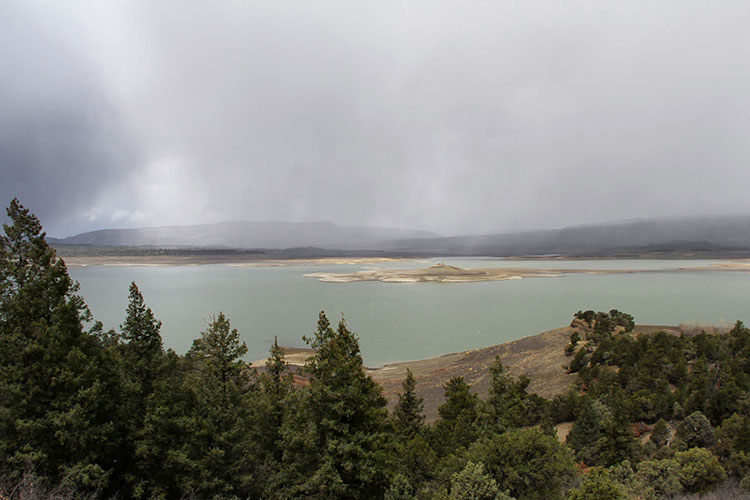- Reclamation
- Upper Colorado
- Albuquerque Office
- Albuquerque Water Operations
- Heron Reservoir
Heron Reservoir

GENERAL
- Owned and operated by the Bureau of Reclamation (Reclamation).
- Built as part of the San Juan-Chama (SJC) Project which is a transmountain diversion that moves water from the San Juan River Basin, across the continental divide, to the Rio Grande Basin for storage in Heron Reservoir, as a component of the Colorado River Storage Project.
- Located on Willow Creek near the confluence with the Rio Chama.
- Strictly for storage and delivery of SJC project water for municipal, domestic, industrial, recreation, irrigation, and fish and wildlife purposes.
- Provides up to 5,000 acre-feet of SJC water annually to maintain recreation pool at Cochiti Reservoir.
- The estimated amount of SJC water that can be provided from Heron Reservoir with reasonable certainty each year (known as Firm Yield) is 96,200 acre-feet.
- If ice cover on the reservoir presents a safety hazard to the public as the reservoir is lowered, releases are terminated until conditions are deemed safe to resume.
- Downstream channel capacity approximately 6,000 cubic feet per second.
- The highest level of water appropriate for safe operation of the dam is 401,000 acre-feet.
- Reclamation conducts periodic Emergency Action Plan exercises of emergency operations with local government agencies to increase agency response times and public safety in the event of a disaster.
SAN JUAN-CHAMA WATER
- SJC water is part of New Mexico’s allocation of the Colorado River, per the Colorado River and Upper Colorado River Compacts.
- Water diverted from the San Juan Basin as part of the SJC Project is subject to the following constraints and considerations:
- Diversions shall not exceed 270,000 acre-feet in any one year.
- Diversions shall not exceed 1,350,000 acre-feet of water in any period of 10 consecutive years.
- Minimum bypass flows must be maintained on San Juan River Basin diversion locations on the Rio Blanco, Little Navajo River, and Navajo River.
- Diversions are maximized after meeting minimum bypass flows.
- Physical constraints of facilities including diversion structures and tunnels.
- Reclamation delivers SJC water to users in the Upper Rio Grande Basin based on water contracts with various entities, commonly referred to as SJC contractors.
- SJC water must be consumptively and beneficially used in New Mexico.
- SJC water must have a downstream destination.
- SJC water must not harm native Rio Grande water.
- SJC water is not subject to provisions of the Rio Grande Compact.
- Once SJC water is released from Heron Reservoir, it belongs to SJC contractors and can potentially be immediately used or stored in other facilities for future use.
STORAGE
- Only imported SJC water may be stored in Heron Reservoir. SJC water stored in Heron Reservoir is subject to the following constraints and considerations:
- Contractors may not carryover storage of SJC water from one diversion season to the next in Heron Reservoir.
- Water not called for by contractors out of Heron Reservoir by December 31, remains in storage as part of the total pool.
- Native Rio Grande Basin water (water originating on the eastern side of the Continental Divide) cannot be stored in Heron Reservoir.
RELEASES
- Releases of SJC water represent either individual decisions made by contractors to call for their water or requests from the Office of the State Engineer to offset depletions of native Rio Grande water caused by groundwater pumping and offset depletions from Rio Grande by contractors upstream of the Rio Chama confluence. Such releases occur in the following manner:
- Releases of between 50 and 200 cubic feet per second (cfs) occur approximately every three to four months to offset depletions caused by groundwater pumping.
- Releases of between 165 and 500 cfs typically occur in the months of November and December in order to deliver the contractors’ annual allocations to downstream storage. However, releases may be made at the call of contractors throughout the year.
- Based on a calculation to determine the amount of native Rio Grande water in Heron Reservoir, a release of native water occurs approximately once a month.
**** All data are provisional and subject to revision as final data are collected and analyzed. ****
Additional Information
Reservoir Data
Streamflow Data
Operational Documents
Project Information
Contact
Please contact the Operations Group via e-mail at ResourceMgr@usbr.gov for additional information.

